The year is 2012. Developers GameFreak are keenly aware that Pokémon Black 2 and White 2 have failed to meet franchise sales targets,1Admittedly this is conjecture. It’s also a matter of perspective – Black & White sold fine, almost matching Ruby & Sapphire and Diamond & Pearl. When seen as “third versions”, B2W2 edged out Platinum. When viewed as standalone, novel adventures however, B2W2’s performance differential is stark. and in light of these circumstances, are seeking to carefully evaluate where Unova lost the broad-based appeal so central to Pokémon’s enduring success. B2W2’s story had focussed on the villainous Neo Team Plasma that sought to rule the world by appropriating everyone’s Pokémon, and GameFreak had lavished attention on a comprehensive postgame built to indulge and satisfy the most wily Pokébattlers. Clearly, this had been the wrong path.
Generation six – christened XY – was to break with these themes quite radically. The new games struck a lighter tone with leitmotifs of “‘beauty’, ‘bonds’, and ‘evolution’”, the plot revolving around “making a better world together” while journeying with friends.2Junichi Masuda, “Hidden Power of Masuda”, #241, November 19, 2013, at: https://www.gamefreak.co.jp/blog/dir_english/2013/11/index.html Any semblance of postgame was stripped out. But, no matter. Because in its stead, fans were treated to something so primordial that it dominated XY’s entire press cycle, a trump card of a most visceral mechanic that when unleashed upon a Pokémon produced awe-inspiring results and got everyone talking. I am, of course, referring to the premier generational gimmick to grace the Pokémon videogames: Mega Evolutions.
The Seed of an Idea
I love Pokémon Black 2 & White 2. They’re, without a doubt, the culmination of years of 2D Pokémon development and positively breathe creative charm. From grandiose scenery set pieces like Sky Arrow Bridge and Dragonspiral Tower to the folksy nostalgia of the Village Bridge song, the games ooze artistic accomplishment. But if I had to surmise why they’ve been outsold by every generation prior and since, I would posit that it’s because rulebooks are difficult to market.
Let me explain. If the average Pokémon game seeks to impress casual gamers first and hardened veterans second, Unova arguably turned that formula on its head. I’m talking specifically about B2W2’s incredible postgame and eccentric innovations in Pokébattle mechanics, which we might consider a case of digging too deep. The Battle Subway, Battle Institute, Pokémon World Tournament, White Treehollow, Black Tower, triple battles and rotation battles – all succeeded in satisfying hardcore fans who craved strategic depth and thrived on theorycraft, but failed to capture the imaginations of the broader Pokémon audience. Simply put, chess-like strategy seldom looks sexy on a promotional poster.
XY, a fresh game on a next-gen system, called for a shift in focus. At the risk of sounding teleological – needed was a new, marketable centerpiece to the battle system that was intuitive and highly visceral, easy to understand yet satisfyingly deep while moreover delivering the absolute eye-popping, jaw-dropping, goes-well-on-a-poster first impression that triple and rotation battles couldn’t.3Incidentally, it’s no coincidence that with Z-Moves, Dynamax and Tera, we’ve had a new gimmick every generation. They scream “this is all new!” to fans and provide direction to the marketing machinery. But what could fit that bill?
In an interview with Nintendo World Report published here on September 24, 2013 – three weeks ahead of XY’s worldwide release – GameFreak Director Junichi Masuda and Chief Designer Hironobu Yoshida shed light on the quest to shake up Pokémon battling as previous generations had known it. In one of the better GameFreak Q&A’s I’ve read, both spoke candidly on the nuances and pitfalls of innovating on a trusted formula. I could summarise, but I think the resulting passage is worth quoting in full:
”The idea [of Mega Pokémon] was one of the original concepts of X and Y when we began developing the games about three years ago. We had the concept of beauty, the concept of bonds, to deepen the relationships between people and Pokémon, as well as the concept of evolution. On the concept of evolution, we were literally just trying to do something new. One thing we were saying was “evolve evolution.” Evolution is one of the defining characteristics of the Pokémon games; however, if we were to just add another stage of evolution and make it a permanent thing, that would mean there is just now stronger Pokémon than the current highest evolution stage. It would make the previous Pokémon weaker and mess with the balance. So, when thinking about how we could do something new with evolution as well as make it a lot of fun for players, we came up with the idea of using Mega Stones and making Mega Evolution just a temporary change during battle.4Justin Berube and Josh Max, “Pokémon X and Y Interview with Game Freak”, Nintendo World Report, September 24, 2013, at: https://www.nintendoworldreport.com/interview/35513/pokemon-x-and-y-interview-with-game-freak
To evolve evolution. To expand the meta without overhauling the existing Pokédex or Pokémon stats. To let players have fun – more fun, presumably, than they’d had with triple or rotation battles. So what did this look like in practice? We’ll let Mr Masuda do the talking once more:
”To trigger Mega Evolution, you have your Pokémon holding a Mega Stone and a button on the bottom of the screen will appear that says “Mega Evolution.” […] By requiring the Mega Stone to Mega Evolve, it prevents the player from holding any other items that may be useful in battle, like Leftovers, berries or a variety of other items. What this does is add quite a bit of strategic depth to the battle, because now you have to read your opponent’s strategy if they’re using a Mega Evolving Pokémon[.]”5Ibid.
Ah yes, battle strategy yada-yada. More importantly, Megas looked cool. Super cool. Because let’s face it, everyone loves the calculated composure of the white-bearded, Confucius-like Mega Alakazam levitating enough of-yet-unbent spoons to make Uri Geller salivate. Or the even beefier Blastoise with Schwerer Gustav strapped to its back and minicannons attached to its paws. Or Mega Salamence that’s turned its crimson wings into a crescent moon hangglider. I could go on.
Megas Revealed
Not that fans, at first, knew these designs were coming. In the early months of 2013, all pre-release attention instead went out to Sylveon, Eevee’s freshly revealed brand-new evolution. This only changed once episode #130 of Pokémon variety show Pokémon Smash (successor to Pokémon Sunday) hit the airwaves on April 7, 2013. In it, Chief Golgo (of Golgo Octillery) and henchman Red Yamamoto (of Yamamoto Whiscash) stopped by GameFreak’s HQ to acquire new XY information directly from the source. Once they’d arrived at GameFreak’s office floor, the pair repeatedly called out for Director Junichi Masuda, only to lose patience and storm inside to – successfully – locate him.
After gently escorting Golgo and Red out into a hallway, viewers found a bemused Mr Masuda standing in front of the apprehensive-looking duo, now forgiven for their intrusion. Masuda held up a rectangular picture frame, its artwork obscured by a giant red question mark pasted across. The overlay “world’s first announcement” flashed on viewers’ television screens, followed by the question “What might the Pokémon illustration be?”.6「世界初公開」, and 「ポケモンのイラストとは?」 Masuda seemed poised to reveal the image, and then… The show cut to scenes of Smash’s resident comedians Robert fooling around with a man-sized Leafeon suit. Typical!

Clockwise, from top-left: (1) Golgo and Red call out to Mr Masuda (2) Mr Masuda holds up a mystery noticeboard; (3) Mega Mewtwo is revealed; (4) Testing M-Mewtwo’s battle prowess. Stills from: Pokémon Smash #130, via pocketmonsters.net
Following this untimely interruption, the show returned to Mr Masuda, who promptly revealed the first illustration of Mega Mewtwo to the world in front of a slack-jawed Golgo and Red. Having been thoroughly amazed, the pair of Chief Golgo and Red Yamamoto then returned to the Smash livestudio7Though not before the Chief had gotten an impromptu foot massage. and, picture frame with depiction of M-Mewtwo in hand, proceeded to wow their fellow cast, studio audience, and viewers at home. The segment concluded by exploring the Pokémon’s incredible battle power in what we may assume was an alpha (or possibly beta) build of XY.
From this point onwards, a full six months out from XY’s release day, Megas became the centre of the Pokéverse’s attention. The official Pokémon Fan Magazine (ポケモンファン), for example, featured various Mega Evolutions on its cover from issues #29-33, that is May through November. Mega Mewtwo in particular appeared on four straight issues (#29-32), a stoically confident look in its eyes every time. And on August 9, 2013, a YouTube trailer teased the first glimpses of two more Mega Pokémon: Mega Lucario and Mega Blaziken. After this, the reveals came thick and fast.
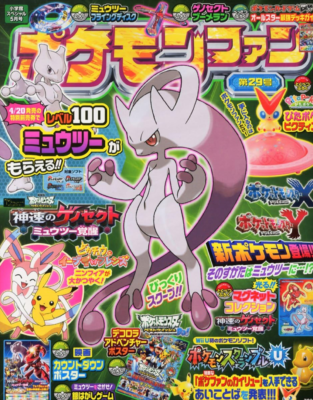
Cover of Pokémon Fan #29, April 20, 2013. M-Mewtwo takes no prisoners. Note also Sylveon on the far left.
Several days later, on August 12, 2013, another YouTube trailer dropped. Supported by a booming voiceover that pithily captured the essence of the Mega (r)evolution – “Mega Evolution! Mega Powerful!” – the Megas of Mawile, Absol and Ampharos were shown for the first time. A September 4 Pokémon Direct confirmed Mega Venusaur, Blastoise and Charizard. And a week later, on September 13, 2013, the veil was lifted on our Pokémon of interest: (Mega) Garchomp. With every new reveal, official website pokemonxy.com added to its rapidly expanding Mega database for fans to marvel at (here). Concurrently over in Japan, the renowned CoroCoro Comic cranked out page after page of Mega imagery, previews and analysis for restive Pokéfans to pour over. Naturally such multimedia found its way out West, too, and to get a sense of the Anglosphere’s obsession with CoroCoro’s XY content, we only need to consider the sheer volume of topical GameFAQs threads created throughout September and October 2013 (here).
The hype was, as they say, very real. And who could fault the fandom. This was the first gimmick, long before Dynamax, to coat familiar Pokémon in a transformative GameFreak sauce and return them instantly recognisable yet vastly, monstrously different. A few cynical Digimon comparisons aside (e.g. here), fans ate it up. So much so that when the ORAS pre-release cycle started, the merest hint of more Megas again stirred up considerable excitement.8See for example: Brenna Hillier, ”Pokemon’s newest mega evolution, Metagross, is the most spectacular yet”, July 14, 2014, at: https://www.vg247.com/pokemon-omega-ruby-alpha-sapphire-mega-evolution-metagross And they still do. To illustrate: Nobody ever calls for Z-Moves to return, yet the notion of Megas coming to Pokemon Legends: Z-A has – to turn a phrase – everyone’s panties in a bunch.
Anyhow, the point is – all this feverish anticipation opened up opportunities to turn up the heat and perhaps let friendly media get a piece of the Mega pie. GameFreak itself was determined to strike first, distributing an XY Torchic holding the power to Mega Evolve – Blazikenite – via global WiFi to players worldwide starting release day. But who would land the second punch? The answer, as so often, was CoroCoro Comic.
CoroCoro Pioneers the Serial Code
To regular readers of this website, CoroCoro will demand little introduction. In business since 1977, CoroCoro is Japan’s premier animanga magazine. Many hallowed comics and franchises have graced its pages, from Doraemon and Dragonball to Medabots and Beyblade. And, of course, Pokémon. CoroCoro was instrumental in the rise of the global cultural phenomenon that is Pocket Monsters, and the benefits flow both ways: CoroCoro promotes Pokémon, and Pokémon sells CoroCoro. As such, the two have worked hand in glove since the late 90s and continue to collaborate closely to this day.
The arrival of XY boded well for this divine partnership. To understand why, we must briefly consider how event Pokémon had been handed out in prior generations. Or rather, the limitations thereof. As of B2W2, any organisation, company or outlet that wished to distribute an event Pokémon in partnership with GameFreak had at their disposal two methods to get the goodies to the end-user. The first option was to hand out the Pokémon locally. In other words, you’d have players show up to an in-life event such as PalCity to download their Mews, Lucarios, Old Sea Maps or what have you by connecting to a local WiFi signal through their in-game’s Mystery Gift menu. Alternatively, as a more primitive solution, certain event Pokémon could be uploaded directly to players’ savefiles by jamming a distribution cartridge into the GBA slot of an old DS Phat; WHF Manaphy and Shokotan Tropius are examples of this method put into practice. Either way, local handovers meant that fans had to turn up in person somewhere, sometime, to grab their special Pokémon. Logistically, this was a challenge that demanded much planning and close liaising with branches of the Pokémon corporate pyramid experienced in handling such events, e.g. the Daisuki Club. (In this regard, it’s a miracle that a distribution like FLET’S Wobbuffet ever happened.)
Not so for the second method, global download, which by default made a particular event Pokémon (or item) available to everyone in the correct region and/or continent who booted up their game within the event period, opened the Mystery Gift menu and searched for gifts. This method was extremely straightforward and hands-off, but for collaborative promotional purposes came with an obvious major drawback – a lack of granularity. Through global download it was still not possible, for instance, to target only the sub-demographic of CoroCoro readers without making them all show up to specific location(s). The vacant space between these local and global options, then, was begging to be filled. And with the advent of Pokémon XY, this finally happened.
XY’s Mystery Gift options for the first time included a “GET WITH CODE” submenu. Since you’re reading this website, you’re probably familiar with the unchanging ritual of Pokémon serial code redeems, but for the sake of comprehensiveness, they’ve worked as follows ever since XY: When an alphanumeric key is submitted, a WiFi connection is established with GameFreak’s servers to check for an active distribution, verify the codeword and, if applicable, initiate download of the corresponding event and create a permanent record thereof in a Wonder Card. And to the average end-user, that’s it. The Pokémon then awaits pickup from an in-game PokéCenter deliveryman. Trivial though these steps, it’s hard to overstate how thoroughly the download code innovation changed the event landscape.9Today, serial code distributions have taken on an increasingly global character, used extensively (some would say overused) to give away everything from World Championship events like EUIC25 Marco Silva’s Jumpluff to anime homages like Liko’s Sprigatito.
In 2013, the newfound finegrainedness to global WiFi meant that, in collaboration with GameFreak, any outlet could now be party to a serial code event without fussing about the complex ground-level logistics, human resources, technology and so on previously required to translate a proposal into an actual distribution. A stack of code booklets and/or leaflets behind the counter sufficed.10In hindsight it’s also evident, however, that the arrival of the serial code heralded the gradual erosion of local distributions, which throughout Gen5 had been some of the most imaginative and memorable in franchise history, It was truly a new method for a new generation. And what better way to road-test this system than by staging a joint promotion with established partners CoroCoro. GameFreak just needed to pick a Pokémon fit for the job. Hmm.
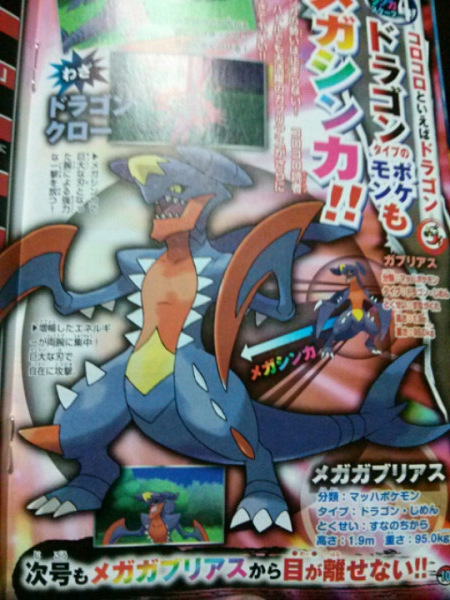
CoroCoro Comic, October 2013, p.10
Garchomp, We Choose You!
With the benefit of hindsight, we can trace a steady CoroCoro buildup towards peak Garchomp frenzy starting with the October 2013 issue. Leaked to Japanese forums by September 11 (official publication date September 15), a sizable image of Mega Garchomp took up half of p.10. “Dragon Types Also Mega Evolve”, screamed the page’s text. Here was yet no hint of distribution, merely a whetting of appetites in preparation for what was to come. That said, the news of Mega Garchamp spread like wildfire to all corners of the Pokéverse, with all of Serebii, PokeBeach, Bulbapedia, Azurilland, and scores of foreign language sites (e.g. here) reproducing the same overexposed CoroCoro photograph. “[L]ooks like something a dude in a giant robot would have to take down”, wrote one fan in response to seeing the image of Mega Garchomp. “Looks like someone used Polymerization on Garchomp & Kabutops”, said another. Remember, fans were starved for Mega news, and the teaser-trailer that flashed Mega Garchomp in blink-and-you-miss-it fashion wouldn’t land until two days later, on September 13.
Fast-forward a month to October 15, and the November issue of CoroCoro hit store shelves. And tucked away inside… Was a surprise distribution announcement! In a two-page spread on p.17-18, Garchomp could be seen slashing away with Dragon Claw accompanied by the words “CoroCoro Mega Push” (コロコロメガ推し) and “You’ll get one in the next issue” (次号、絶対入手せよ). A header announced the “Pokémon Meets CoroCoro First in History Project” (ポケモン×コロコロ史上初プロジェクト). And to make the magazine’s intent abundantly clear, an even larger footer read “Garchomp Gift to All Readers!” (ガブリアス読者全員プレゼント!!!). To spread the news far and wide, official website pokemon.co.jp also published an October 15 Garchomp announcement (here). It took pains to emphasise that a serial code compatible with XY was to be included in CoroCoro’s December issue, and it also – somewhat anticlimactically – spoiled Garchomp’s full moveset. Regardless, a mere three days after Pokémon XY’s worldwide release, Japanese Pokéfans had become intimately acquainted with CoroCoro’s plans to host world’s first Pokémon serial code distribution.
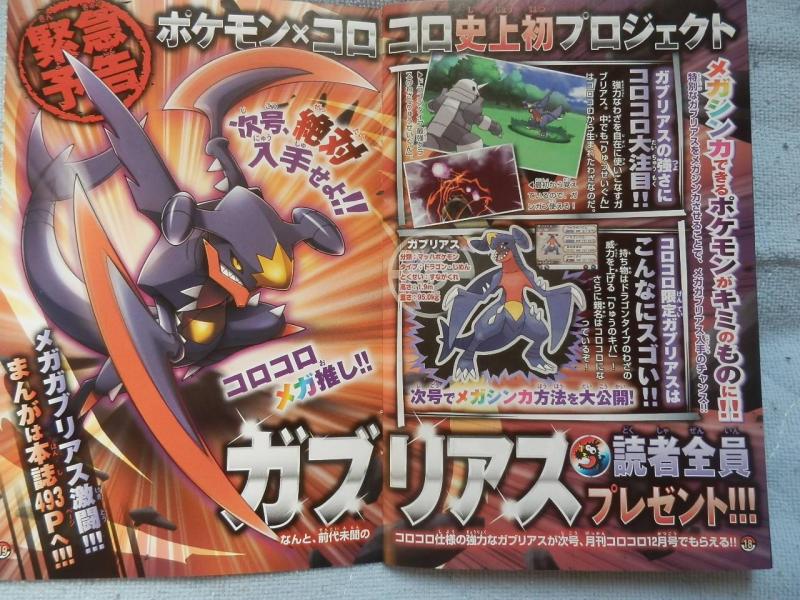
CoroCoro Comic, November 2013, p.17-18
All this begs the question: Out of 700+ Pokémon in the Dex, why bestow this honour upon Garchomp? There had been a Strongest Class Garchomp distribution for B2W2 barely a year prior! I, too, struggle to fully explain the choice. To be sure, the Mach Pokémon was a popular pseudo-Legendary, and it met an essential criterion: its Mega Stone, Garchompite, was in the game. This as opposed to Mega Flygon, for example, which got axed from XY owing to doubts over the various iterations of its design, or Mega Metagross, which followed in the second mainline game to feature Megas: Omega Ruby & Alpha Sapphire. The Mega Stone requirement alone narrowed the candidate pool significantly, but it still included such illustrious candidates as Mawile, Absol, Ampharos, and Lucario. Why Garchomp over any of these? Truthfully, we may never know.
Still, it is evident that Garchomp’s distribution was savvily designed. For one, the Mach Pokémon‘s timely early distribution window – beginning a month from XY’s release – ensured that players could press it into service during their initial playthroughs of the game. However, CoroCoro Garchomp did not come with a Mega Stone, and in XY, Garchompite isn’t found until Victory Road. Thus, the absence of Garchompite guaranteed that players would be unable to deploy the raw destructive power of Mega Garchomp to (fully) trivialise their journeys. Not until they were ready to thwomp the Elite Four and/or tackle XY’s skeletal postgame would they have Garchomp’s full potential at their fingertips. Naturally, CoroCoro took care to point out Garchompite‘s location in the game, thereby creating a carrot that dangled in front of players for the length of their adventure – genius!
Once mid-November 2013 rolled around, the highly anticipated CoroCoro Garchomp distribution finally went live. After ripping the shrink wrap from CoroCoro’s December 2013 issue (ft. Garchomp’s giddy face on the cover) and flicking through its pages, fans discovered a small insert as a supplementary mid-magazine tearout. This, too, featured artwork of a ferocious (Mega) Garchomp, accompanied by the text “Limited CoroCoro Garchomp Gift” (コロコロ完全限定ガブリアスプレゼント). Opening the booklet showed step-by-step serial code redeem instructions for XY, as well as a unique 16-digit alphanumeric key. A pokemon.co.jp official webpage similarly provided download instructions. Serial code distributions had become a reality.11For the select few who ordered their XY copies from the Japanese PokeCenter Online, Garchomp may have been their second serial code experience – PCO preorders came with a bonus code for 10 Quick Balls.
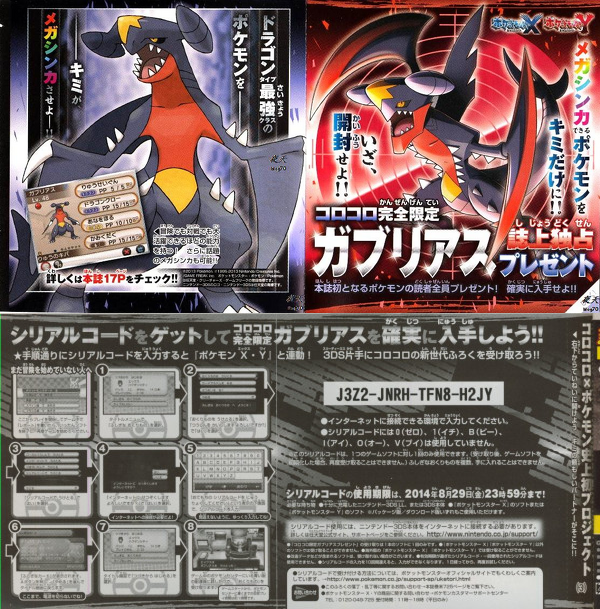
CoroCoro Garchomp tearout (top); Inside of booklet (bottom). Via pokeaogtytnsy (here) and pocketmonsters.net, respectively.
Now… Did excitement over Megas translate to greater sales of CoroCoro’s December 2013 issue? CoroCoro’s publisher, Shogakukan, shares its magazine sales figures on an annual basis. While we can tell from the data that monthly circulation rose sharply over the period Oct 2013-Sep 2014 (the start of the XY bloc) compared to the absolute lows of the year prior (the B2W2 bloc),12See: https://en.wikipedia.org/wiki/CoroCoro_Comic#irculation it is, as far as I know, impossible to find month-to-month rolling data that could inform us whether the Garchomp promotion spurred an immediate sales boost.
What is abundantly clear, however, is that fans thought Garchomp sufficiently interesting to blog, vlog and post about. Several videos captured the process of claiming and inspecting a CoroCoro Garchomp, such as this guy on NicoNico who even taped the magazine unboxing. Or these (here and here) YouTubers who recorded the redemption process and/or their Garchomp’s stats. I think it safe to say that these individuals were motivated more by pride in their acquisition or a desire to document the historicity of the distribution, and not by a businesslike need to “video proof” their event Pokémon as became common practice from 2016 onwards. As was the case for blogger “doherodreamofpikachu”, for example, who in their excitement attempted to claim Garchomp in the early hours of November 14, found that the gift wasn’t live yet, and only successfully pulled in Garchomp on their second attempt late that evening. Or take blogger “kyoukinosata”, who wrote passionately:
”I’m so deeply engrossed in Pokémon that I think I’m out of my mind, but I also want related merchandise! Even if it’s just digital data, I want it! I’m in such a frenzy that I bought a Corocoro Comic with a serial code to get a special Garchomp… […] I’m sure there will be many more related products like this in the future, and I want to get as many as I can.”
Only blogger “clipclop” seemed to be underwhelmed, finding Garchomp “completely normal, except that it comes in a Cherish Ball.”
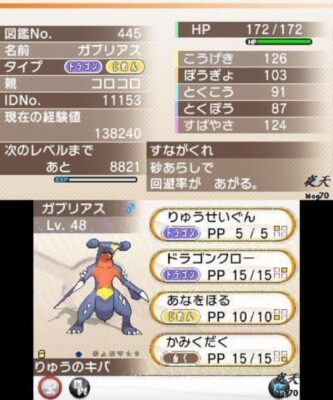
Image credit: pokeaogtytnsy (here)
I’d have to disagree there, clipclop! Garchomp was quite unique. In a first-ever, its Original Trainer echoed the parent magazine, コロコロ (CoroCoro). The Trainer ID of 11153 stood for its release date of November 15, 2013. Garchomp was contained in a bright-red Cherish Ball, held a Dragon Fang (not Garchompite), and had a random nature and IVs. It knew Draco Meteor / Dragon Claw / Dig / Crunch to come out guns blazing as a mixed attacker. Importantly, Garchomp arrived at Lv.48, resulting in full obedience to any XY player that had claimed their third badge, the Rumble Badge won from Korrina, halfway through their adventure. If we consider Garchomp’s low arrival level, early release window, and the fact that its serial codes would be valid for almost ten months (until August 29, 2014), we may conclude that this Garchomp was fully intended to be used as a heavy-duty, Mega-capable sweeper on ongoing playthroughs (and not as a sit-pretty premium collectible). We can only hope that many players took the offer, for ‘ole Chomp was sure to spice up their gameplay.
Wrapping Up
GameFreak had evolved evolution. And in so doing, they had put the franchise’s future back on firm(er) footing. XY outsold B2W2 by a factor of 2:1 (roughly 16 million to 8 million copies), and also outperformed the original BW (15 million). Perhaps themes of harmony do indeed resonate better with Pokémon’s core demographic. (Is this why we’ve been blessed with overly friendly rivals Hau and Hop the past generations?)Critics liked XY, too. At the Japan Game Awards, XY won the “Greatest Award, the Best Sales Award, and the Global Award”. At the UK’s Golden Joystick Awards 2014, the games won the “Greatest Handheld Game” category. Junichi Masuda blogged about these developments ecstatically and expressed profound gratitude to fans, a significant burden – I can only assume – lifted off his shoulders.
And Megas? Fans weren’t done. Remakes ORAS, jam-packed with many more novel Mega evolutions, outsold XY. After this, things fell silent on the Mega front to make room for Z-Moves and Dynamax, but fans’ calls for Megas to return did not. (Take this 2022 DualShockers article, for example.) Megas of course came to Pokémon GO in 2020, and as we mentioned earlier, are set to return to mainline games in Pokémon Legends: Z-A. TheGamer perhaps best articulated the prevailing fanbase sentiment upon learning this news – ”finally!” – in a 2024 article titled “I’m Glad Mega Evolution Is Back, But It Should Have Never Gone Away”. Quite! Let’s hope, then, that Megas are now here to stay.
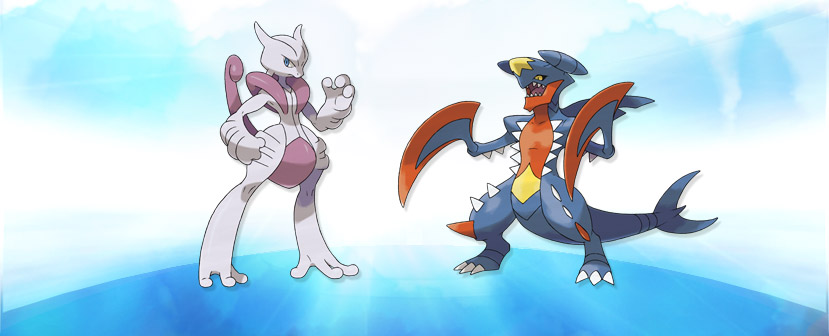
- Harvest Moon 3 (2001) - March 5, 2020
- Pokémon Trading Card Game 2 (2001) - February 5, 2020
- Yu-Gi-Oh! Dark Duel Stories (2002) - January 5, 2020
